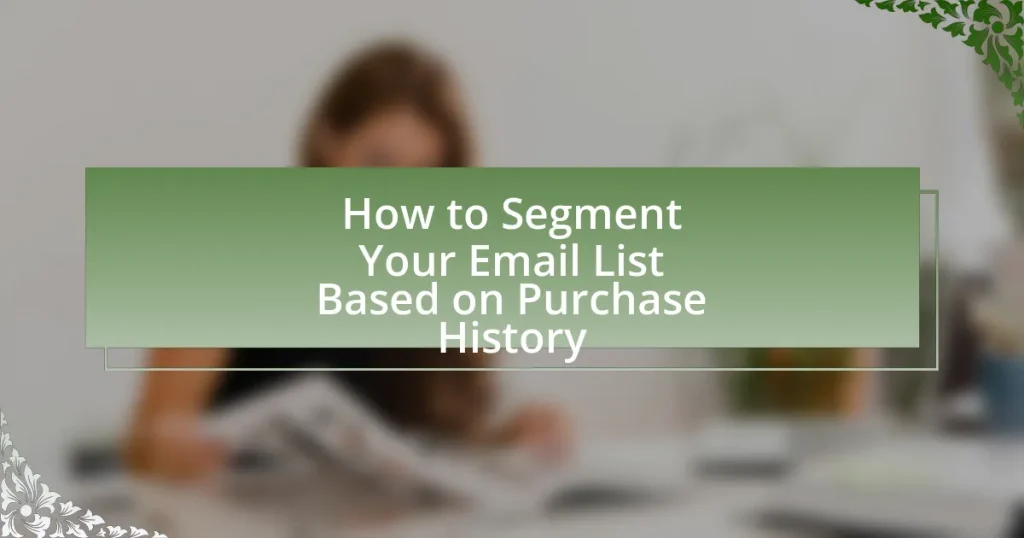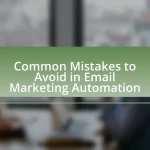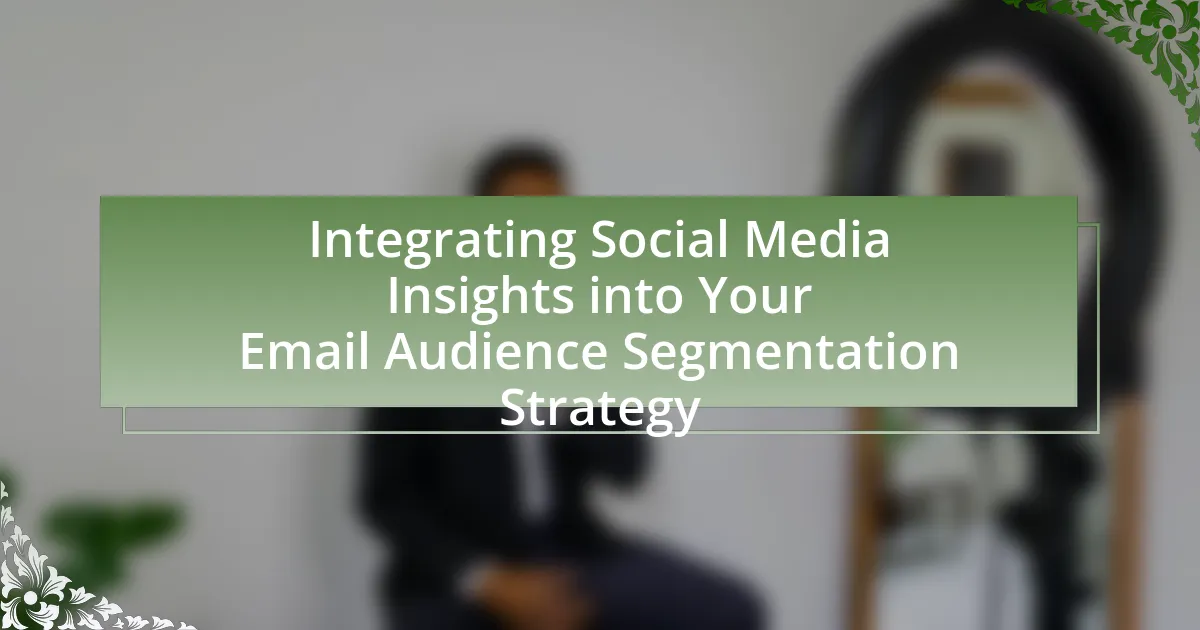Email list segmentation based on purchase history is a strategic approach that involves categorizing subscribers according to their past buying behaviors to enhance marketing effectiveness. This article outlines the significance of using purchase data, such as transaction history and frequency of purchases, to create targeted email campaigns that improve engagement and conversion rates. It discusses various segmentation methods, the benefits of personalized marketing, and best practices for maintaining effective segments. Additionally, the article highlights the importance of analytics tools and customer feedback in refining segmentation strategies to optimize email marketing outcomes.
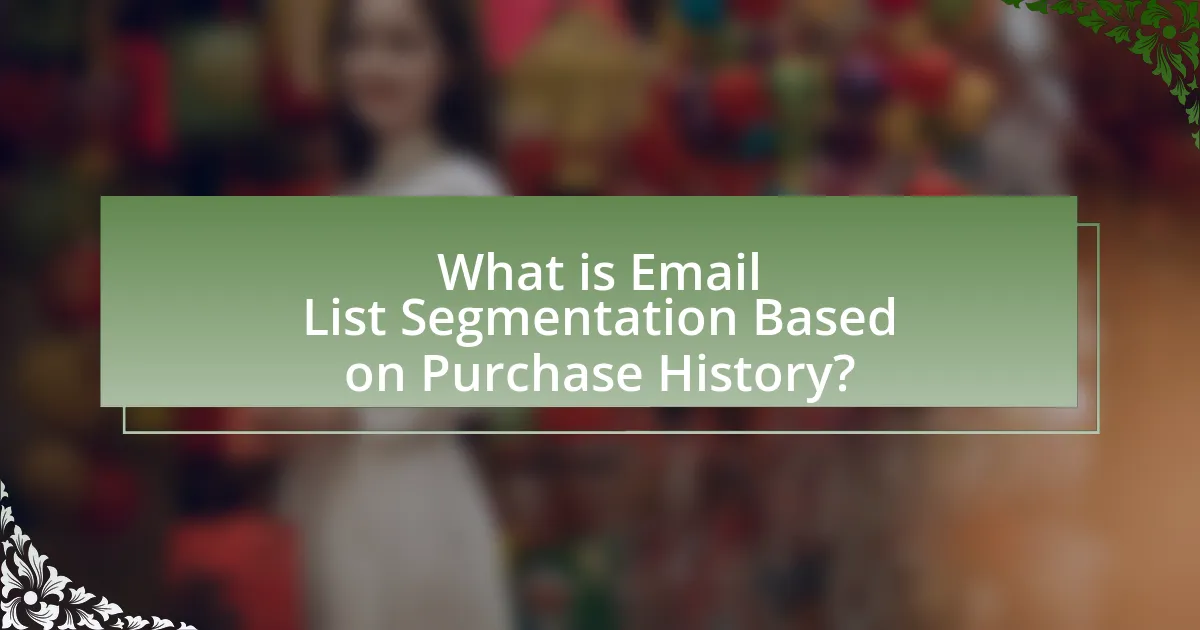
What is Email List Segmentation Based on Purchase History?
Email list segmentation based on purchase history is the process of dividing an email subscriber list into distinct groups based on their past buying behaviors. This method allows marketers to tailor their email campaigns to specific customer preferences and purchasing patterns, enhancing engagement and conversion rates. For instance, a study by Mailchimp found that targeted emails based on customer behavior can lead to a 14% higher open rate and a 10% increase in click-through rates. By analyzing data such as frequency of purchases, types of products bought, and average order value, businesses can create personalized marketing strategies that resonate with different segments of their audience.
How does purchase history influence email list segmentation?
Purchase history significantly influences email list segmentation by allowing marketers to categorize subscribers based on their previous buying behaviors. This categorization enables targeted messaging, as customers who have purchased similar products can receive tailored promotions that align with their interests. For instance, a study by the Direct Marketing Association found that segmented email campaigns can lead to a 760% increase in revenue, demonstrating the effectiveness of using purchase history for segmentation. By analyzing data such as frequency of purchases, types of products bought, and average order value, businesses can create specific segments that enhance engagement and conversion rates.
What types of purchase data can be used for segmentation?
Purchase data types that can be used for segmentation include transaction history, purchase frequency, average order value, product categories purchased, and customer lifetime value. Transaction history provides insights into what products customers buy and when, allowing for targeted marketing strategies. Purchase frequency indicates how often customers make purchases, which can help identify loyal customers versus occasional buyers. Average order value reveals spending habits, enabling segmentation based on budget. Product categories purchased allow businesses to tailor offers based on customer preferences. Customer lifetime value assesses the total revenue a customer is expected to generate, guiding segmentation for high-value customers.
How can purchase frequency affect segmentation strategies?
Purchase frequency significantly influences segmentation strategies by allowing businesses to categorize customers based on their buying behavior. High-frequency purchasers can be targeted with loyalty programs and exclusive offers, while low-frequency buyers may benefit from re-engagement campaigns to encourage more frequent purchases. Research indicates that 80% of a company’s future revenue comes from just 20% of its existing customers, highlighting the importance of identifying and nurturing high-frequency buyers. This targeted approach enhances marketing efficiency and improves customer retention rates.
Why is segmenting your email list important?
Segmenting your email list is important because it allows for targeted communication, which increases engagement and conversion rates. By dividing your audience based on specific criteria, such as purchase history, marketers can tailor their messages to meet the unique needs and preferences of different segments. Research shows that segmented email campaigns can lead to a 760% increase in revenue, highlighting the effectiveness of personalized marketing strategies. This targeted approach not only improves customer satisfaction but also enhances the overall return on investment for email marketing efforts.
What benefits does segmentation provide for email marketing campaigns?
Segmentation enhances email marketing campaigns by allowing marketers to tailor messages to specific audience groups, resulting in higher engagement rates. By dividing the email list based on factors such as purchase history, demographics, or behavior, marketers can send personalized content that resonates with each segment. Research indicates that segmented campaigns can lead to a 760% increase in revenue, demonstrating the effectiveness of targeted messaging. This approach not only improves open and click-through rates but also fosters customer loyalty and retention, as recipients feel more valued and understood.
How does segmentation improve customer engagement and retention?
Segmentation improves customer engagement and retention by allowing businesses to tailor their marketing efforts to specific groups based on shared characteristics or behaviors. By analyzing purchase history, companies can create targeted campaigns that resonate with individual customer preferences, leading to higher open rates and click-through rates. For instance, a study by Mailchimp found that segmented email campaigns had a 14.31% higher open rate compared to non-segmented campaigns. This targeted approach not only enhances the relevance of communications but also fosters a sense of personalization, making customers feel valued and understood, which in turn increases their likelihood of repeat purchases and long-term loyalty.

What are the key methods for segmenting your email list?
The key methods for segmenting your email list include demographic segmentation, behavioral segmentation, engagement level segmentation, and purchase history segmentation. Demographic segmentation involves categorizing subscribers based on age, gender, location, and income, allowing for targeted messaging that resonates with specific groups. Behavioral segmentation focuses on user actions, such as email opens, clicks, and website visits, enabling marketers to tailor content based on engagement patterns. Engagement level segmentation divides the list into active, inactive, and new subscribers, facilitating personalized re-engagement strategies. Purchase history segmentation analyzes past buying behavior to create targeted campaigns that promote relevant products or services, enhancing customer retention and increasing sales. These methods are supported by data showing that segmented email campaigns can lead to a 760% increase in revenue, highlighting their effectiveness in improving marketing outcomes.
How can you categorize customers based on their purchase behavior?
Customers can be categorized based on their purchase behavior by analyzing their buying patterns, frequency, and monetary value of purchases. This categorization typically involves segmenting customers into groups such as high-value customers, frequent buyers, occasional buyers, and one-time purchasers. For instance, high-value customers are those who consistently spend above a certain threshold, while frequent buyers make regular purchases regardless of the amount spent. Research indicates that businesses can increase retention rates by targeting these segments with tailored marketing strategies, as highlighted in a study by Kumar and Reinartz (2016) in “Creating Enduring Customer Value.” This approach allows companies to optimize their email marketing efforts by sending personalized content that resonates with each customer segment’s specific behaviors and preferences.
What are the different categories for segmenting based on purchase history?
The different categories for segmenting based on purchase history include frequency of purchase, recency of purchase, monetary value of purchases, product category, and customer loyalty status. Frequency of purchase categorizes customers based on how often they buy, while recency of purchase focuses on how recently a customer made a purchase. Monetary value categorizes customers by the total amount spent, product category segments customers based on the types of products purchased, and customer loyalty status identifies customers as new, repeat, or loyal based on their buying behavior. These categories enable targeted marketing strategies that can enhance customer engagement and increase sales.
How can you identify high-value customers through segmentation?
To identify high-value customers through segmentation, businesses can analyze purchase history data to categorize customers based on their spending patterns and frequency of purchases. By employing metrics such as Customer Lifetime Value (CLV), which quantifies the total revenue a customer is expected to generate over their relationship with the business, companies can pinpoint those who contribute the most to their bottom line. For instance, a study by McKinsey & Company found that 20% of customers typically account for 80% of a company’s profits, highlighting the importance of targeting this segment. Additionally, segmenting customers into tiers based on their transaction history allows businesses to tailor marketing strategies and enhance customer retention efforts effectively.
What tools can assist in segmenting your email list?
Email marketing platforms such as Mailchimp, ActiveCampaign, and Klaviyo can assist in segmenting your email list. These tools offer features that allow users to categorize subscribers based on their purchase history, engagement levels, and demographic information. For instance, Mailchimp provides advanced segmentation options that enable marketers to create targeted campaigns based on specific customer behaviors, such as past purchases or browsing activity. ActiveCampaign allows for dynamic segmentation, which updates automatically as customer data changes, ensuring that the right messages reach the right audience. Klaviyo specializes in e-commerce and offers robust segmentation capabilities that leverage purchase data to tailor marketing efforts effectively.
Which email marketing platforms offer segmentation features?
Several email marketing platforms offer segmentation features, including Mailchimp, Constant Contact, ActiveCampaign, and HubSpot. Mailchimp allows users to create segments based on various criteria such as purchase history, engagement levels, and demographics. Constant Contact provides similar capabilities, enabling segmentation based on customer behavior and preferences. ActiveCampaign excels in advanced segmentation options, allowing for dynamic segments that update automatically based on user actions. HubSpot also offers robust segmentation tools that integrate with its CRM, allowing for targeted campaigns based on detailed customer data. These platforms are widely recognized for their effective segmentation features, making them suitable for businesses looking to optimize their email marketing strategies based on purchase history.
How can analytics tools enhance your segmentation efforts?
Analytics tools enhance segmentation efforts by providing data-driven insights that allow for precise targeting of customer groups. These tools analyze purchase history, demographic information, and behavioral patterns, enabling marketers to identify distinct segments within their email lists. For example, a study by McKinsey & Company found that companies using advanced analytics for segmentation can achieve up to 10% higher conversion rates. By leveraging these insights, businesses can tailor their messaging and offers to specific segments, improving engagement and driving sales.
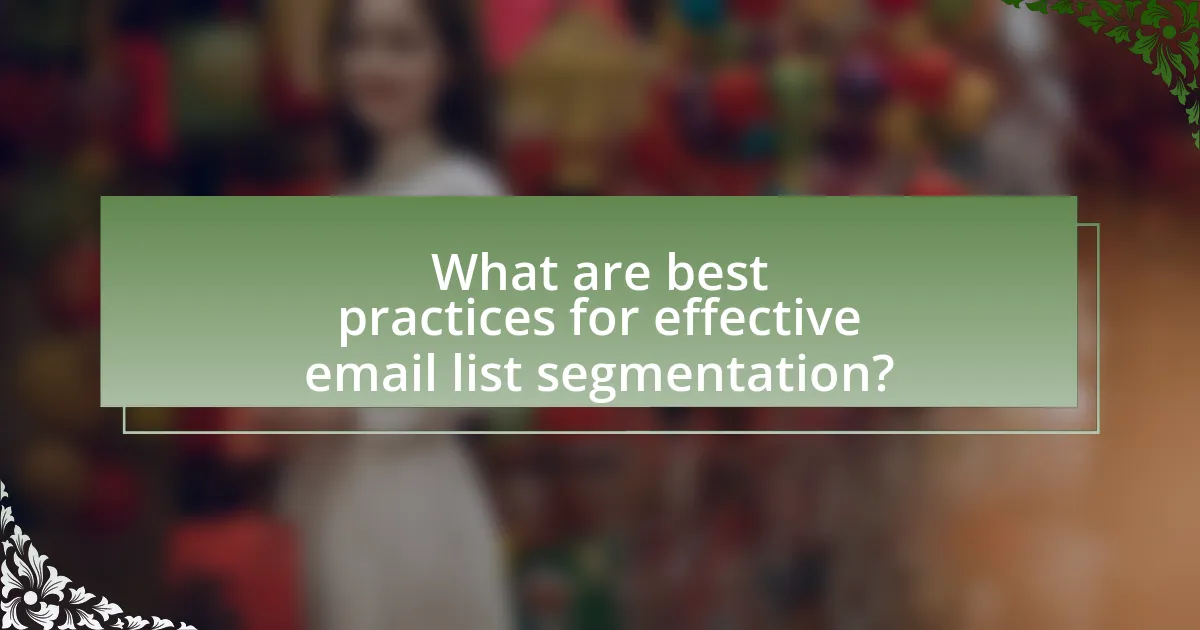
What are best practices for effective email list segmentation?
Effective email list segmentation involves categorizing subscribers based on specific criteria to enhance targeting and engagement. Best practices include utilizing purchase history to create segments such as frequent buyers, one-time purchasers, and cart abandoners. This targeted approach allows marketers to tailor messages that resonate with each group, increasing open rates and conversions. Research indicates that personalized emails can lead to a 29% higher open rate and a 41% higher click-through rate, demonstrating the effectiveness of segmentation strategies. Additionally, regularly updating segments based on changing behaviors ensures that the email content remains relevant and engaging for subscribers.
How often should you update your email segments?
You should update your email segments at least quarterly. Regular updates ensure that your segments reflect the most current purchase behaviors and preferences of your subscribers. According to a study by Mailchimp, segmented campaigns can lead to a 14.31% higher open rate, emphasizing the importance of maintaining accurate and relevant segments.
What factors should trigger a re-evaluation of your segments?
A re-evaluation of your segments should be triggered by significant changes in customer behavior, market trends, or product offerings. For instance, if there is a noticeable shift in purchasing patterns, such as an increase in demand for a specific product category, it indicates that segments may no longer align with current customer interests. Additionally, changes in demographic data, such as age or location, can necessitate a reassessment of segments to ensure they accurately reflect the target audience. Market research, such as the 2021 McKinsey report, highlights that 75% of consumers have changed their shopping behavior during economic shifts, underscoring the importance of regularly updating segments to maintain relevance and effectiveness in marketing strategies.
How can you test the effectiveness of your segments?
To test the effectiveness of your segments, you can analyze key performance indicators (KPIs) such as open rates, click-through rates, and conversion rates for each segment. By comparing these metrics against your overall email performance, you can determine which segments are yielding the best results. For instance, a study by Mailchimp found that segmented campaigns can lead to a 14.31% higher open rate and a 100.95% higher click-through rate compared to non-segmented campaigns. This data supports the effectiveness of targeted segmentation in improving engagement and sales outcomes.
What common mistakes should you avoid in email list segmentation?
Common mistakes to avoid in email list segmentation include failing to define clear segmentation criteria, neglecting to update segments regularly, and not analyzing engagement metrics. Defining clear criteria ensures that segments are meaningful and targeted, while regular updates maintain relevance as customer behaviors change. Analyzing engagement metrics, such as open and click rates, provides insights into the effectiveness of segmentation strategies. According to a study by Mailchimp, segmented campaigns can lead to a 14.31% higher open rate, highlighting the importance of avoiding these common pitfalls for improved email marketing performance.
How can over-segmentation harm your email marketing strategy?
Over-segmentation can harm your email marketing strategy by leading to decreased engagement and increased unsubscribe rates. When a business segments its email list too finely, it risks sending overly tailored messages that may not resonate with recipients, resulting in lower open and click-through rates. According to a study by Mailchimp, segmented campaigns can see a 14.31% higher open rate, but excessive segmentation can dilute this benefit, as recipients may feel overwhelmed or confused by the frequency and specificity of the emails they receive. This can ultimately lead to a negative perception of the brand and a loss of subscribers.
What are the risks of not segmenting your email list at all?
Not segmenting your email list poses significant risks, including reduced engagement and increased unsubscribe rates. When emails are sent to a broad audience without considering individual preferences or behaviors, recipients are less likely to find the content relevant, leading to lower open and click-through rates. According to a study by Mailchimp, segmented campaigns can lead to a 14.31% higher open rate compared to non-segmented ones. Additionally, irrelevant emails can frustrate subscribers, resulting in higher unsubscribe rates, which can damage brand reputation and reduce overall email deliverability.
What practical tips can enhance your segmentation strategy?
To enhance your segmentation strategy, utilize data analytics to identify customer behaviors and preferences. Analyzing purchase history allows for the creation of targeted segments based on factors such as frequency of purchases, average order value, and product categories. For instance, a study by McKinsey & Company found that companies using advanced analytics for customer segmentation can increase their marketing ROI by 15-20%. Implementing personalized email campaigns based on these segments can significantly improve engagement rates and conversion.
How can personalized content improve engagement with segmented lists?
Personalized content significantly improves engagement with segmented lists by delivering tailored messages that resonate with individual preferences and behaviors. When email lists are segmented based on purchase history, personalized content can address specific interests, leading to higher open and click-through rates. For instance, a study by Experian found that personalized emails generate six times higher transaction rates compared to non-personalized emails. This demonstrates that when recipients receive content relevant to their past purchases, they are more likely to engage, ultimately enhancing customer loyalty and driving sales.
What role does customer feedback play in refining your segments?
Customer feedback is crucial in refining segments by providing insights into customer preferences and behaviors. This feedback allows businesses to identify trends and patterns that inform the segmentation process, ensuring that segments are based on actual customer experiences rather than assumptions. For instance, a study by HubSpot found that companies utilizing customer feedback for segmentation saw a 20% increase in engagement rates, demonstrating the effectiveness of aligning segments with customer input.
